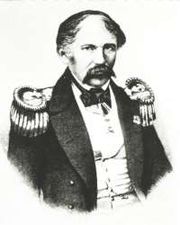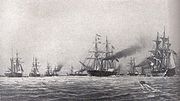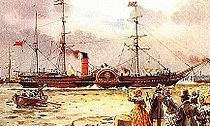
Reichsflotte
Encyclopedia

German Navy
The German Navy is the navy of Germany and is part of the unified Bundeswehr .The German Navy traces its roots back to the Imperial Fleet of the revolutionary era of 1848 – 52 and more directly to the Prussian Navy, which later evolved into the Northern German Federal Navy...
. It was founded on 14 June 1848 during the Revolutions of 1848 in the German states
Revolutions of 1848 in the German states
The Revolutions of 1848 in the German states, also called the March Revolution – part of the Revolutions of 1848 that broke out in many countries of Europe – were a series of loosely coordinated protests and rebellions in the states of the German Confederation, including the Austrian Empire...
by the Frankfurt Parliament
Frankfurt Parliament
The Frankfurt Assembly was the first freely elected parliament for all of Germany. Session was held from May 18, 1848 to May 31, 1849 in the Paulskirche at Frankfurt am Main...
to provide a naval force in the First Schleswig War against Denmark.
History
The German ConfederationGerman Confederation
The German Confederation was the loose association of Central European states created by the Congress of Vienna in 1815 to coordinate the economies of separate German-speaking countries. It acted as a buffer between the powerful states of Austria and Prussia...
, founded in 1815, was initially not in need of a navy, as it could rely on three members who commanded large fleets: The Grand Duke of Luxembourg
Grand Duke of Luxembourg
The Grand Duke of Luxembourg is the sovereign monarch and head of state of Luxembourg. Luxembourg has been a grand duchy since 15 March 1815, when it was elevated from a duchy when placed in personal union with the United Kingdom of the Netherlands...
as commander of the Royal Dutch Navy, the Duke of Holstein as the commander of the Danish Navy, and last but not least, the King of Hanover as commander of the British Royal Navy
Royal Navy
The Royal Navy is the naval warfare service branch of the British Armed Forces. Founded in the 16th century, it is the oldest service branch and is known as the Senior Service...
. This had changed by the late 1830s, though, as the Kings of the Netherlands and Great Britain ceased to be members of the German Confederation, and Denmark turned against Germany in the First Schleswig War that started in early 1848. Soon, the Danish Navy stopped all German trade in the North Sea
North Sea
In the southwest, beyond the Straits of Dover, the North Sea becomes the English Channel connecting to the Atlantic Ocean. In the east, it connects to the Baltic Sea via the Skagerrak and Kattegat, narrow straits that separate Denmark from Norway and Sweden respectively...
and the Baltic Sea
Baltic Sea
The Baltic Sea is a brackish mediterranean sea located in Northern Europe, from 53°N to 66°N latitude and from 20°E to 26°E longitude. It is bounded by the Scandinavian Peninsula, the mainland of Europe, and the Danish islands. It drains into the Kattegat by way of the Øresund, the Great Belt and...
.
This newly-created provisional government was headed by Archduke Johann of Austria
Archduke Johann of Austria
Archduke John of Austria was a member of the Habsburg dynasty, an Austrian field marshal and German Imperial regent .-Biography:...
as regent
Regent
A regent, from the Latin regens "one who reigns", is a person selected to act as head of state because the ruler is a minor, not present, or debilitated. Currently there are only two ruling Regencies in the world, sovereign Liechtenstein and the Malaysian constitutive state of Terengganu...
(Reichsverweser), i.e., as a temporary head of state
Head of State
A head of state is the individual that serves as the chief public representative of a monarchy, republic, federation, commonwealth or other kind of state. His or her role generally includes legitimizing the state and exercising the political powers, functions, and duties granted to the head of...
. Johann named as August von Jochmus
August Giacomo Jochmus
August Giacomo Jochmus Freiherr von Cotignola was an Austrian lieutenant field marshal, and minister of the German Confederation...
as Foreign Minister and Navy minister.

German Confederation
The German Confederation was the loose association of Central European states created by the Congress of Vienna in 1815 to coordinate the economies of separate German-speaking countries. It acted as a buffer between the powerful states of Austria and Prussia...
turned over its budget to the parliament on 12 June 1848. Only two days later, the parliament decided to spend 6 million Reichsthaler
Reichsthaler
The Reichsthaler was a standard Thaler of the Holy Roman Empire, established in 1566 by the Leipzig convention. It was also the name of a unit of account in northern Germany and of a silver coin issued by Prussia.-Reichsthaler coin:...
for a navy under Prince Adalbert of Prussia
Adalbert of Prussia
Prince Adalbert of Prussia was a son of Prince Wilhelm of Prussia and Landgravine Marie Anna of Hesse-Homburg. He was a naval theorist and admiral. He was instrumental during the Revolutions of 1848 in founding the first unified German fleet, the Reichsflotte...
. When he had to resign due to an order by the King of Prussia, Konteradmiral Karl Rudolf Brommy
Karl Rudolf Brommy
Rear Admiral Karl Rudolf Brommy was a German naval officer who helped establish the first unified German fleet, the Reichsflotte, during the First Schleswig War which broke out just before the Revolutions of 1848 in the German...
took over.


Ship of the line
A ship of the line was a type of naval warship constructed from the 17th through the mid-19th century to take part in the naval tactic known as the line of battle, in which two columns of opposing warships would manoeuvre to bring the greatest weight of broadside guns to bear...
Christian VIII and the sail frigate Gefion
SMS Gefion
SMS Gefion was a light cruiser of the Kaiserliche Marine launched in 1893. The cruiser was named after Gefjon of Norse mythology. Under the 1891 naval regulations she was classified as a corvette-cruiser, but in 1899 was reclassified to light cruiser...
entered the Bay of Eckernförde
Eckernförde
Eckernförde is a German city in Schleswig-Holstein, Kreis Rendsburg-Eckernförde at the Baltic Sea near Kiel. The population is about 23,000.All German submarines are stationed in Eckernförde....
, only to be repelled by coastal artillery. Christian VIII exploded and sank, while the Gefion was captured and renamed Eckernförde by the Germans.
In the Battle of Heligoland (1849)
Battle of Heligoland (1849)
The first Battle of Heligoland took place on 4 June 1849 during the First Schleswig War and pitted the fledgling all-German navy known as the Reichsflotte , which had been founded less than a year prior, against the Royal Danish Navy, which had blocked German naval trade in North Sea and Baltic Sea...
on 4 June 1849, the fleet under Brommy saw its first and only combat action, which also remains the first and only naval combat under the black-red-gold Flag of Germany
Flag of Germany
The flag of Germany is a tricolour consisting of three equal horizontal bands displaying the national colours of Germany: black, red, and gold....
.
Until 1852, the fleet had
- 2 sail frigateFrigateA frigate is any of several types of warship, the term having been used for ships of various sizes and roles over the last few centuries.In the 17th century, the term was used for any warship built for speed and maneuverability, the description often used being "frigate-built"...
s : Deutschland (1848), EckernfördeEckernfördeEckernförde is a German city in Schleswig-Holstein, Kreis Rendsburg-Eckernförde at the Baltic Sea near Kiel. The population is about 23,000.All German submarines are stationed in Eckernförde....
(captured Danish SMS Gefion (1852)) - 3 steam frigateFrigateA frigate is any of several types of warship, the term having been used for ships of various sizes and roles over the last few centuries.In the 17th century, the term was used for any warship built for speed and maneuverability, the description often used being "frigate-built"...
s : SMS Barbarossa (ex-RMS BritanniaRMS BritanniaThe RMS Britannia was an ocean liner of the British and North American Royal Mail Steam Packet Company, later known as Cunard Steamship Company. She was launched on 5 February 1840, at the yard of Robert Duncan & Company in Greenock, Scotland...
), Erzherzog Johann, Hansa (1848) - 1 sail corvetteCorvetteA corvette is a small, maneuverable, lightly armed warship, originally smaller than a frigate and larger than a coastal patrol craft or fast attack craft , although many recent designs resemble frigates in size and role...
: Franklin (ship) (donated by Hamburg, not accepted) - 6 steam corvetteCorvetteA corvette is a small, maneuverable, lightly armed warship, originally smaller than a frigate and larger than a coastal patrol craft or fast attack craft , although many recent designs resemble frigates in size and role...
s : Der Königliche Ernst August, Großherzog von Oldenburg, Frankfurt (1848), Bremen (1848), Hamburg (1841), Lübeck (1844) - 27 gunboatGunboatA gunboat is a naval watercraft designed for the express purpose of carrying one or more guns to bombard coastal targets, as opposed to those military craft designed for naval warfare, or for ferrying troops or supplies.-History:...
s
On 2 April 1852, the Reichsflotte was dissolved. While most ships were sold off, two 2 steam frigates were given to the Prussian Navy
Prussian Navy
Throughout the centuries, Prussia’s military consistently concentrated on its land power, and never sought a similar power at sea. Yet historically there were always Prussian naval forces , beginning in the days when "Prussia" meant only the Margraviate of Brandenburg.- The Navy of Electoral...
, which later evolved into the Northern German Federal Navy (Norddeutsche Bundesmarine
Norddeutsche Bundesmarine
The Norddeutsche Bundesmarine was the Navy of the North German Confederation, formed out of the Prussian Navy. It was eventually succeeded by the Kaiserliche Marine in 1871.-External links:*...
, 1866-1871) and became the Imperial Navy (Kaiserliche Marine
Kaiserliche Marine
The Imperial German Navy was the German Navy created at the time of the formation of the German Empire. It existed between 1871 and 1919, growing out of the small Prussian Navy and Norddeutsche Bundesmarine, which primarily had the mission of coastal defense. Kaiser Wilhelm II greatly expanded...
, 1872-1918).
Names
Several names are used for this Navy. The resolution of 14 June 1848 just calls it "Deutsche Marine", while Marine minister Arnold DuckwitzArnold Duckwitz
Arnold Duckwitz was a German statesman and merchant who served as Minister of Trade and of the Navy in the provisional government of the Frankfurt Assembly of 1848-49, and as mayor of Bremen.From early to mid 1848, he participated as an expert in the economic committee of the Frankfurt National...
in 1849 reported about the "Deutsche Kriegsmarine
Kriegsmarine
The Kriegsmarine was the name of the German Navy during the Nazi regime . It superseded the Kaiserliche Marine of World War I and the post-war Reichsmarine. The Kriegsmarine was one of three official branches of the Wehrmacht, the unified armed forces of Nazi Germany.The Kriegsmarine grew rapidly...
" and when Karl Rudolf Brommy
Karl Rudolf Brommy
Rear Admiral Karl Rudolf Brommy was a German naval officer who helped establish the first unified German fleet, the Reichsflotte, during the First Schleswig War which broke out just before the Revolutions of 1848 in the German...
was promoted to its first Admiral, the name used was "Reichsmarine
Reichsmarine
The Reichsmarine was the name of the German Navy during the Weimar Republic and first two years of Nazi Germany. It was the naval branch of the Reichswehr, existing from 1918 to 1935...
", which was used within the Navy, too. To avoid confusion with later incarnations, historians settled for Reichsflotte. The term Bundesflotte (Federal fleet) is also used, but this is misleading, as it was not operated by the German Confederation
German Confederation
The German Confederation was the loose association of Central European states created by the Congress of Vienna in 1815 to coordinate the economies of separate German-speaking countries. It acted as a buffer between the powerful states of Austria and Prussia...
, but by the parliament which had adopted a constitution for a German Empire
German Empire
The German Empire refers to Germany during the "Second Reich" period from the unification of Germany and proclamation of Wilhelm I as German Emperor on 18 January 1871, to 1918, when it became a federal republic after defeat in World War I and the abdication of the Emperor, Wilhelm II.The German...
, the Reichsverfassung ("Imperial Constitution").
The "Verfassung des Deutschen Reichs", article III § 19, states:
- [1] The naval forces are the exclusive affair of the Reich. It is not allowed for any single state to maintain its own warships or hire privateers.
- [2] The crews of the war navy are a part of the new German defence force (the term "WehrmachtWehrmachtThe Wehrmacht – from , to defend and , the might/power) were the unified armed forces of Nazi Germany from 1935 to 1945. It consisted of the Heer , the Kriegsmarine and the Luftwaffe .-Origin and use of the term:...
" is used). They are independent of the land forces. - [3] The size of the crews to be provided for the war navy from each state, is to be calculated from the number of land forces to be maintained by it. Details on this matter, as well as the balancing of costs between the Reich government and the individual states, will be determined by law.
- [4] The commissioning of officers and officials of the naval forces are under the sole authority of the Reich.
- [5] The care for equipping, training and maintaining a war fleet and the creation, equipping and maintenance of military harbours and arsenals falls under the authority of the Reich.
- [6] The matters pertaining on the appropriations necessary for the establishment of military harbours and naval installations, as well as on the responsibilities of the corresponding Reich services will be determined by Reich laws.
External links
- Deutsche Marine, History
- http://www.deutsches-marinearchiv.de/Archiv/1848-1867/Bundesflotte/einsatz.htm
- SMS Barbarossa

